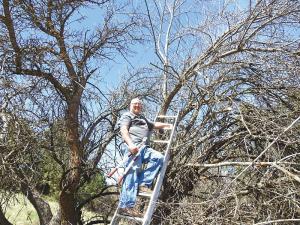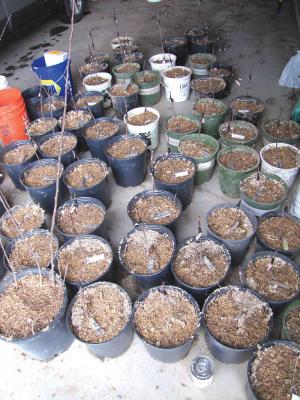Apple Detectives Find Lost Varieties
Long lost trees are bearing fruit for apple detectives David Benscoter and E.J. Brandt. The two have dedicated hundreds of hours and many miles of travel to find lost apple varieties in eastern Washington and Idaho. The hours include searching through old newspaper clippings, seed catalogs, and meeting with descendants of early settlers, all with the goal of finding abandoned orchards.
“We go out and search old homesteads for apple trees,” says Benscoter. “If we find apples we can’t identify using old books and nursery catalogs, we send the apples on to the Temperate Orchard Conservancy in Oregon. They maintain an orchard of more than 5,000 varieties.”
Benscoter got the bug to find lost apples when asked by an older friend to pick apples for her from her orchard. While she and her brother knew what two of the varieties were, others were a mystery.
An online search yielded no answers, but did acquaint Benscoter with the concept of lost apples, varieties that appeared to have died out. Along with names of other apple detectives, he learned about Creighton Lee Calhoun Jr.’s book “Old Southern Apples.” About half of the apple varieties listed in the book were thought to be extinct.
When Benscoter later discovered that 3 or 4 of the “extinct” apples had been exhibited at his local Whitman County Fair between 1900 and 1910, he was hooked. “The fair gave a prize for each variety exhibited, and the local paper listed every variety entered and who won,” says Benscoter. “I decided to go look for the lost ones.”
He began searching county records and pulled out old plat books, looking for names of people who had entered the contest. Soon he was driving around each fall searching for old apple trees and trying to identify the variety. Eventually he partnered with Brandt. With the help of the Whitman County Historical Society, the two established the nonprofit Lost Apple Project.
“The nonprofit status allows us to raise money so we can reimburse the Temperate Orchard Conservancy for their help,” explains Benscoter. “In 2018 we sent them apples from around 200 trees. They identified 10 previously lost varieties.”
In the 9 years since he began his search, he and Brandt have found more than 23 varieties previously thought extinct, as well as any number of rare, old varieties. The Sary Sinap found in 2018 had not been seen in years, but originated in Turkey and is considered an ancient variety. They estimate another 25 lost varieties remain to be found.
“We conduct our searches in the fall when the apples are on the tree, take samples and geolocate the tree,” explains Benscoter. “Once we have identified the apple, if it is one we want to propagate, we return to the tree in February to collect scion wood.”
Many of the identified varieties have found their way into Benscoter’s nursery for scion wood. “We have around 30 trees in the orchard, every one with grafts from at least 5 different varieties,” says Benscoter. “One 30-year old tree has grafts from more than 35 varieties.”
Benscoter reports ever-increasing interest in ordering the old varieties. While they can’t send trees out of state, they can send scion wood.
“We charge $4 for the first stick and $3 for additional pieces of scion wood,” he says.
The Lost Apple Project is growing in other ways as well. Benscoter reports a sister organization has formed in southern Idaho and another in Michigan called Lost Apples Midwest.
Contact: FARM SHOW Followup, David Benscoter, 6414 East Chattaroy Rd., Chattaroy, Wash. 99003 (ph 509 238-5150; dbens23@gmail.com; www.facebook.com/lostappleproject/).

Click here to download page story appeared in.
Click here to read entire issue
Apple Detectives Find Lost Varieties AG WORLD Long lost trees are bearing fruit for apple detectives David Benscoter and E J Brandt The two have dedicated hundreds of hours and many miles of travel to find lost apple varieties in eastern Washington and Idaho The hours include searching through old newspaper clippings seed catalogs and meeting with descendants of early settlers all with the goal of finding abandoned orchards “We go out and search old homesteads for apple trees ” says Benscoter “If we find apples we can’t identify using old books and nursery catalogs we send the apples on to the Temperate Orchard Conservancy in Oregon They maintain an orchard of more than 5 000 varieties ” Benscoter got the bug to find lost apples when asked by an older friend to pick apples for her from her orchard While she and her brother knew what two of the varieties were others were a mystery An online search yielded no answers but did acquaint Benscoter with the concept of lost apples varieties that appeared to have died out Along with names of other apple detectives he learned about Creighton Lee Calhoun Jr ’s book “Old Southern Apples ” About half of the apple varieties listed in the book were thought to be extinct When Benscoter later discovered that 3 or 4 of the “extinct” apples had been exhibited at his local Whitman County Fair between 1900 and 1910 he was hooked “The fair gave a prize for each variety exhibited and the local paper listed every variety entered and who won ” says Benscoter “I decided to go look for the lost ones ” He began searching county records and pulled out old plat books looking for names of people who had entered the contest Soon he was driving around each fall searching for old apple trees and trying to identify the variety Eventually he partnered with Brandt With the help of the Whitman County Historical Society the two established the nonprofit Lost Apple Project “The nonprofit status allows us to raise money so we can reimburse the Temperate Orchard Conservancy for their help ” explains Benscoter “In 2018 we sent them apples from around 200 trees They identified 10 previously lost varieties ” In the 9 years since he began his search he and Brandt have found more than 23 varieties previously thought extinct as well as any number of rare old varieties The Sary Sinap found in 2018 had not been seen in years but originated in Turkey and is considered an ancient variety They estimate another 25 lost varieties remain to be found “We conduct our searches in the fall when the apples are on the tree take samples and geolocate the tree ” explains Benscoter “Once we have identified the apple if it is one we want to propagate we return to the tree in February to collect scion wood ” Many of the identified varieties have found their way into Benscoter’s nursery for scion wood “We have around 30 trees in the orchard every one with grafts from at least 5 different varieties ” says Benscoter “One 30-year old tree has grafts from more than 35 varieties ” Benscoter reports ever-increasing interest in ordering the old varieties While they can’t send trees out of state they can send scion wood “We charge $4 for the first stick and $3 for additional pieces of scion wood ” he says The Lost Apple Project is growing in other ways as well Benscoter reports a sister organization has formed in southern Idaho and another in Michigan called Lost Apples Midwest Contact: FARM SHOW Followup David Benscoter 6414 East Chattaroy Rd Chattaroy Wash 99003 ph 509 238-5150; dbens23@gmail com; www facebook com/lostappleproject/
To read the rest of this story, download this issue below or click
here to register with your account number.








